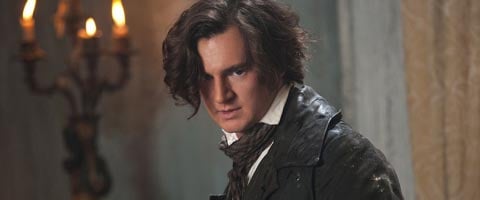To 3D Or Not To 3D: Buy The Right Abraham Lincoln: Vampire Hunter Ticket

You probably never thought you'd have the chance to see our 16th President fight vampires in glorious 3D, but modern Hollywood truly is an amazing and unpredictable thing. This weekend's Abraham Lincoln: Vampire Hunter doesn't just reimagine the Civil War as a battle between humans and the undead, but it presents it in the third dimension-- all for a story that takes place before movies were even invented.
So if you're on board with this revised version of American history, is the 3D ticket worth the extra cost? As usual, we're here to help you figure that out, with the latest installment of To 3D or not to 3D. We go through the 3D effects in Abraham Lincoln: Vampire Hunter step by step to see how it all works, and at the end give you a summary judgment that ought to let you know which is the right ticket to buy. Let's get to it!
Does It Fit?
A typical biopic of Abraham Lincoln is pretty much the opposite of what you'd expect to see in 3D. But the vampire hunting twist adds a lot of opportunities, namely big spurts of vampire blood and Abe swinging his silver-tipped axe around. Then again, vampires aren't such big fans of the sun, and a lot of the movie takes place a night-- typically not a good match for 3D effects. We'll call this one pretty much a draw.
Fit Score: 3/5
Planning & Effort
Director Timur Bekmambetov talked from the set about planning the film with 3D in mind, though he eventually made the choice to post-convert rather than shoot with 3D cameras. So this isn't one of those situations where 3D was forced on him after the fact, and you can tell in several shots that he really set them up to take advantage of the third dimension. Then again, you've got to knock a point for a movie that isn't willing to go whole hog and take the 3D cameras for a spin.
P&E Score: 4/5
Before the Window
Your Daily Blend of Entertainment News
Some may call this element of 3D the gimmicky part-- you know, where things fly off the screen at you, as if they're "before" the window of the screen. I think this is the fun part, and Abraham Lincoln: Vampire Hunter takes good advantage of it, though occasionally in bad taste (a whip flying out at the screen before it strikes a young boy? Really?) Abe's axe comes off the screen a few times, as do streams of vampire blood, and though the chaotic action style doesn't let these moments pop as much as they should, at least Bekmambetov gives it a shot.
Before the Window Score: 4/5
Beyond the Window
So if "before the window" means things pop toward you, "beyond the window" refers to the opposite effect, when 3D makes the screen appear especially deep, with space stretching out in front of you. This is a 3D effect that post-conversion never, ever does as well as native 3D, and Abraham Lincoln is no different. It's hard to even think of a single scene that feels especially deep-- and given how many scenes take place on battlefields, that's really a missed opportunity.
Beyond the Window Score:1/5
Brightness
Especially after the devastating dimness in Brave, I was really pleasantly surprised by the brightness of Abraham Lincoln, which jacks the brightness way up to compensate for the many, many scenes that take place at night. Timur Bekmambetov's frenetic action style may not always make it easy to tell what's happening, but it's definitely bright enough, so kudos to the 3D team who made sure your sunglasses-like 3D glasses won't mask the film in any way.
Brightness Score: 5/5
The Glasses Off Test
My favorite way to test whether a 3D movie is really earning your cash is to take off your glasses in the middle of a scene. If the image looks really blurry, it's going to really pop in 3D when you put the glasses back on; if it looks essentially unchanged, you know the depth isn't really there. Abraham Lincoln failed the glasses-off test over and over again, to the point that some scenes seriously looked identical without glasses on. This, again, is a common problem in 3D post-conversion, and pretty strong proof that the 3D here is just an extra gloss rather than something crucial to the film's execution.
Glasses Off Test: 1/5
Audience Health
Bad 3D sometimes has the side effect of making the audience sick, as you try to orient yourself while all those 3D planes slide around. Abraham Lincoln, possibly because the 3D effect isn't that strong, doesn't really have that problem. You might not feel the dramatic 3D depth, but you won't need a barf bag either.
Health Score: 5/5
| SCORES RECAP | |
| 3D Fit | 3 |
| P&E | 4 |
| Before The Window | 4 |
| Beyond The Window | 1 |
| Brightness | 5 |
| The Glasses Off Test | 1 |
| Audience Health | 5 |
| Total Score | 23 (out of a possible 35) |
Final Verdict: This is pretty much straight down the middle for a 3D score, and Abraham Lincoln is pretty typical of modern post-converted 3D films-- not egregiously bad, but never really demonstrating the necessity of the 3D to begin with. It's nice to see Bekmambetov have a little fun with the over-the-top potential for 3D-- he's an over-the-top kind of director-- but he really should have shot in 3D if he wanted to take proper advantage of it. You can easily skip the 3D surcharge on this and see Honest Abe kill vampires in regular old 2D.
This poll is no longer available.
For more 3D analysis, visit our To 3D Or Not To 3D archive right here.
Staff Writer at CinemaBlend

